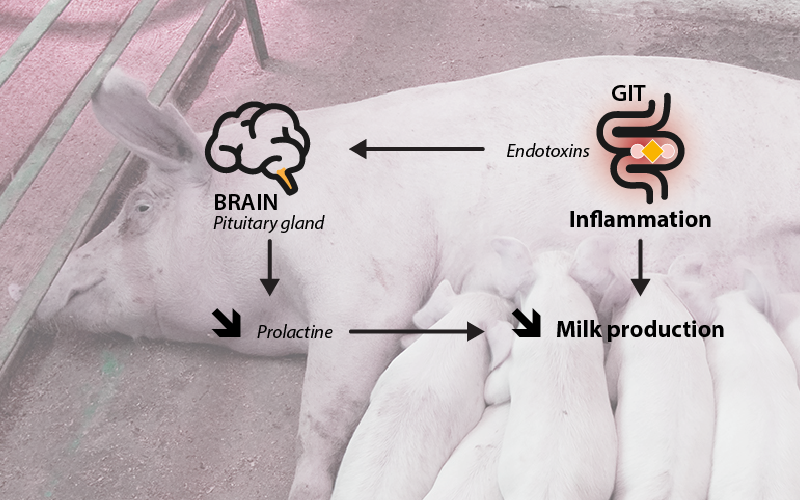Tackle negative effects of endotoxins during sows lactation period!
Improving pork production
With a world population exceeding 8 billion, food & feed security is a major issue. As pork meat is the most common protein source for millions of people around the world, supporting and improving pork production is of major importance.
One of the factors influencing the profitability of pork production is the development of healthy, heavy, uniform and resilient piglets. The amount and quality of milk produced by sows during the first weeks of the piglet’s life (pre-weaning period) plays a vital role in this process. Modern sows can produce 10 to 12 kg milk/day.
Maintaining those high levels of milk production throughout their lactation period is dependent on adequate levels of energy and nutrients. Removing factors, such as endotoxins, that negatively affect the availability of energy and nutrients to achieve the required level of lactation is key.
Endotoxins
Also known as Lipopolysaccharides (LPS), are large molecules consisting of a lipid and a polysaccharide composed of O-antigen, outer core and inner core joined by a covalent bond; they are found in the outer membrane of Gram-negative bacteria.
The peripartum period
The peripartum period is also known as a risk period for endotoxins due to the many changes sows go through.
Danijela Gnjatovic, DVM
Hormonal changes & re-housing
During the peripartum period, the sow goes through many changes and experiences extensive metabolic stress, shifting from an anabolic to a catabolic state.
Dietary changes
In addition, to prepare sows for farrowing, the gestation diet is replaced with a farrowing diet. Not only the composition of the diet but also the amount of feed is changed in the 10-30 days prior to farrowing. These dietary changes affect the sow’s gut microbiota by favoring a shift towards Gram-negative bacteria.
Moreover, constipation is frequently reported in perinatal sows. Due to the lowered passage rate of the digesta, the intestinal microbiota has more time to proliferate, and the release of endotoxins in the intestinal lumen is increased.
Gut permeability is compromised
In addition, gut permeability around farrowing is compromised promoting the leakage of endotoxins from the lumen of the gut to the sow’s circulation.
Once endotoxins reach the circulation, inflammatory responses are initiated, diverting energy and nutrients towards the immune system and lowering their availability for lactation.
Lactation period
Postpartum Dysgalactia Syndrome (PPDS)
Is a common disease in sows worldwide. Affected sows have a decreased milk production during the first days after parturition (giving birth). The reduced milk production has serious consequences for new-born piglets.
Effect of endotoxins
Prolactin is a hormone that plays an important role in the initiation and maintenance of milk production and regulation of many other physiological processes such as reproduction, fat metabolism, and immune response. Bacterial endotoxins have been found to suppress the release of prolactin by the pituitary gland. Endotoxins do not only suppress prolactin production but also decrease the amount of circulating thyroid hormone which is related to milk synthesis and increase the concentration of cortisol which acts pro-inflammatory.
Neonatal problems
All of the above lead to a complex multifactorial syndrome called Postpartum dysgalactia syndrome (PPDS) resulting in lower milk production and is the primary cause of neonatal problems such as diarrhea, crushing, runting, inanition and poor piglet growth.

Weaning-to-oestrus interval
Effect of endotoxins
Endotoxins not only affect milk production around farrowing but can also impair the reproductive-neuroendocrine function by disrupting the ovarian cyclicity and prolonging the sow’s weaning-to-oestrus interval.
After farrowing, the development of new follicles is naturally suppressed by two key hormones, prolactin and luteinizing hormone (LH), which are produced and released in response to the suckling effect of the piglets. This natural process helps the sow to be properly introduced into the next oestrus cycle with the right number and size of follicles and boosts the sows production results.
A potent negative modulator
Endotoxins are a potent negative modulator of LH secretion and act as a prolactin suppressant which could disrupt the natural process of follicular development.
Conclusion
The peripartum period is the most stressful part of the sow’s production cycle. Endotoxins present an additional pressure on the sow’s energy balance during the peripartum period as they initiate an inflammatory response and divert energy and nutrients toward the immune system. In addition, endotoxins also negatively affect the sow’s milk production and weaning-to-oestrus interval.
As endotoxins are present always and everywhere and cannot be avoided in the environment of the sows, it is recommended to use EndoBan during sow production. EndoBan is a unique product designed to remove endotoxins and stimulate a natural defense mechanism against endotoxins in the gut lumen.
References are available upon request.



